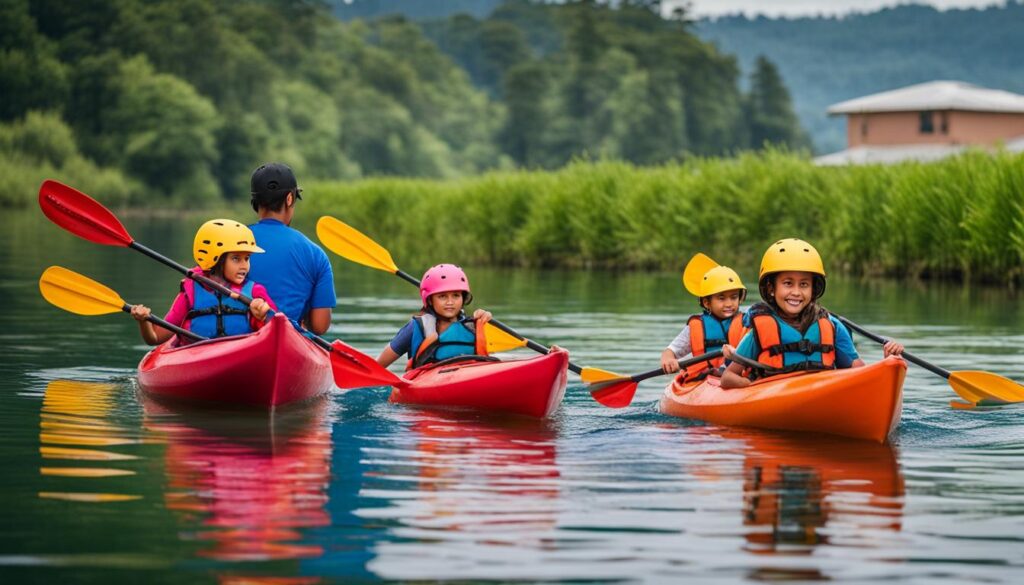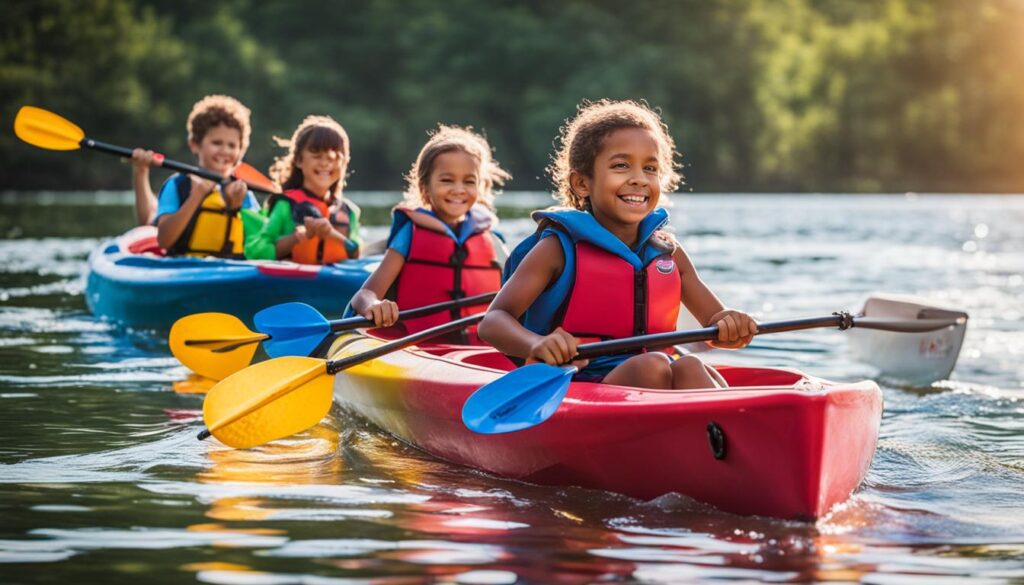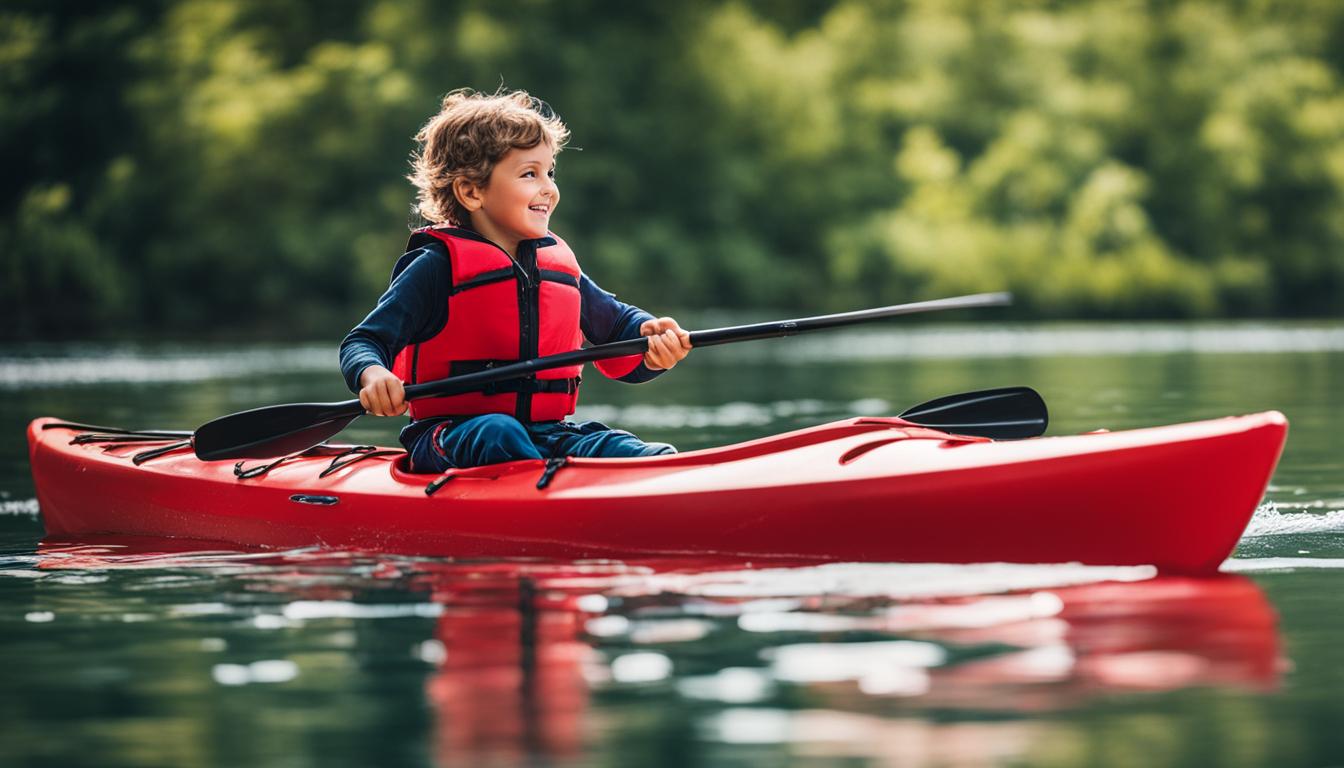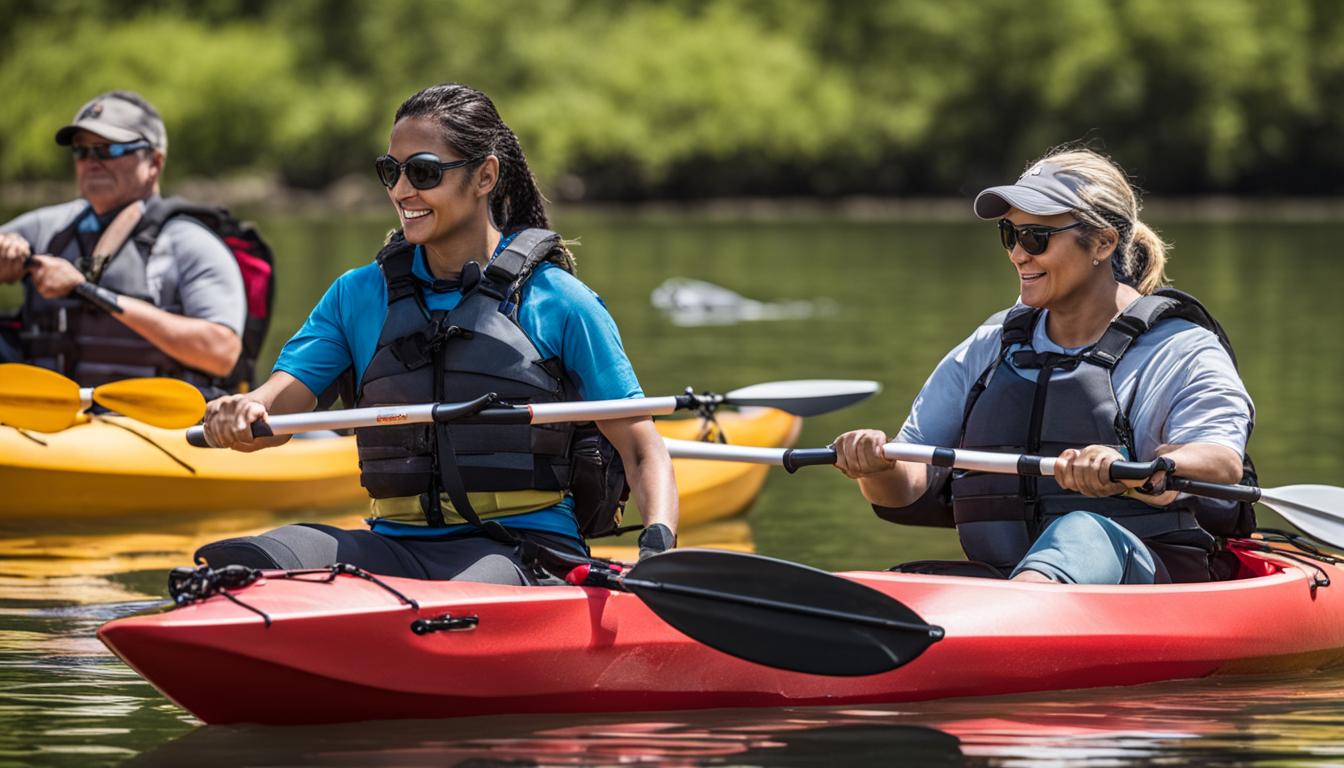Are you a parent or guardian looking to introduce your child to the exciting world of kayaking? Adapting kayaking techniques for kids can make this outdoor activity more accessible and enjoyable for younger paddlers. By customizing kayaking methods, you can ensure that your child has a safe and thrilling experience on the water.
Key Takeaways:
- Adaptive gear such as kayaks, paddles, and stabilizing floats can be used to make kayaking more accessible for kids.
- When choosing a kayak for your child, look for one with a large cockpit and a length of at least 10 feet.
- Adaptive paddles can help kids with strength or mobility limitations in their upper bodies.
- Kayak stabilizing floats can provide added stability and balance for young paddlers.
- Seating systems and hand and wrist aids can enhance comfort and support for kids during kayaking.
Choosing the Right Kayaks for Kids
When it comes to kayaking with kids, choosing the right kayak is essential for a safe and enjoyable experience. Child-friendly kayaking methods and specialized kayaking tactics for kids ensure that they can navigate the water comfortably and confidently. Here are some key factors to consider when selecting kayaks for kids.
Size and Stability
Kayaks for kids should be sturdy and of good quality, able to handle the weight of young paddlers. Look for kayaks that are at least 10 feet in length and can accommodate paddlers of 175 pounds or more. Larger cockpits make it easier for kids to enter and exit the kayak, promoting independence and reducing the risk of capsizing.
Entry and Exit Options
For young paddlers with limited mobility, kayaks with large cockpits or sit-on-top kayaks are great options. Large cockpits provide ample space for easy entry and exit, while sit-on-top kayaks allow paddlers to sit on the top of the kayak rather than inside. These options are particularly beneficial for kids who may struggle with traditional kayak entry and exit techniques.
Tandem Kayaks
If your child has no paddling experience or limited coordination, consider tandem kayaks. These kayaks accommodate two paddlers, allowing an experienced adult or older child to paddle with the younger paddler. Tandem kayaks provide additional stability and guidance, making it a great choice for introducing kids to kayaking.

Table: Choosing the Right Kayaks for Kids
Selecting Adaptive Paddles for Kids
When it comes to kayaking with kids, selecting the right paddle is crucial for their comfort and success on the water. For young paddlers with strength or mobility limitations in their upper bodies, adaptive paddles can provide additional support and optimize their paddling techniques.
One option to consider is using mount-supported paddle systems that reduce stress on the joints and require less range of motion. These systems provide stability and help young paddlers maintain a steady rhythm while paddling. Lightweight carbon fiber paddles or bent shaft paddles may also be suitable for some children, as they are lighter and easier to maneuver.
By choosing adaptive paddles that cater to their specific needs, kids can develop their kayaking skills and enjoy a comfortable and efficient paddling experience. It’s important to ensure that the paddles provide support and contribute to the overall stability and safety of the young paddlers.
Table: Comparison of Adaptive Paddle Options
| Paddle Type | Features |
|---|---|
| Mount-Supported Paddle Systems | – Reduce stress on joints – Require less range of motion – Provide stability |
| Carbon Fiber Paddles | – Lightweight – Easy to maneuver |
| Bent Shaft Paddles | – Easier grip – Optimal paddling angle |
It’s important to assess the individual needs of each young paddler and consult with experts or instructors who specialize in adaptive kayaking. They can provide guidance on the most suitable paddle options and offer advice on techniques that can enhance stroke modifications for children. With the right adaptive paddles, kids can enjoy the thrill of kayaking while building confidence and improving their skills on the water.
Enhancing Stability with Kayak Stabilizing Floats
If your young paddler has limited coordination or mobility, kayak stabilizing floats, also known as outriggers, can greatly enhance stability and balance on the water. These floats provide additional support, making it easier for kids to stay upright and confident in their kayaks. By reducing the risk of capsizing, outriggers give young paddlers the freedom to focus on enjoying the kayaking experience.
The size and position of the pontoon floats can be adjusted based on the individual’s needs, ensuring optimal stability without hindering maneuverability. The added buoyancy of the floats creates a wider base, increasing the kayak’s overall stability. This is especially beneficial for children with paralysis, spinal cord injuries, or other conditions that affect their ability to maintain balance.
When using kayak stabilizing floats, it’s important to ensure that they are securely attached to the kayak. Proper installation and regular maintenance are crucial for optimal performance and safety. By incorporating outriggers into your child’s kayaking setup, you can provide them with a stable and secure platform to explore the water with confidence.
Outriggers provide added stability and balance, making it easier for young paddlers to stay upright.
Benefits of Kayak Stabilizing Floats
| Benefits | Explanation |
|---|---|
| Enhanced stability | Outriggers provide a wider base, increasing overall stability and reducing the risk of capsizing. |
| Improved balance | The added support of stabilizing floats helps young paddlers maintain balance, even with limited coordination or mobility. |
| Increased confidence | With the assurance of stability, kids can paddle with confidence, enjoying the freedom and excitement of kayaking. |
| Reduced risk of accidents | Kayak stabilizing floats minimize the chances of tipping over, ensuring a safer kayaking experience for young paddlers. |
By incorporating kayak stabilizing floats into your child’s kayaking setup, you can provide them with a secure and stable platform to develop their paddling skills. These floats not only enhance safety but also boost confidence, allowing young paddlers to fully enjoy the thrills of kayaking.
Ensuring Comfort with Seating Systems
When it comes to kayaking with children, ensuring their comfort is essential. Seating systems play a crucial role in providing the necessary support and stability for young paddlers with different disabilities. There are various options available to personalize the kayaking experience for children and optimize their comfort.
Gel pad seats or inflatable seats that conform to the backside and legs can alleviate pressure points and provide a more comfortable seating arrangement. Foam supports and tape can also be used to offer added support for the trunk or pelvic area. Additionally, specially manufactured adaptive seats are available for young paddlers who require substantial back, neck, lateral, and hip support.
It is important to choose seating systems that prioritize safety and can accommodate the specific needs of children. By providing a comfortable and supportive seating arrangement, children can enjoy kayaking and focus on the excitement of being on the water.

Table: Comparison of Seating Systems for Children
| Seating System | Description | Benefits |
|---|---|---|
| Gel pad seats or inflatable seats | Seats that conform to the backside and legs | – Alleviate pressure points – Provide comfort – Conform to the body shape |
| Foam supports and tape | Supports added to the trunk or pelvic area | – Provide additional support – Improve stability – Customizable placement |
| Adaptive seats | Specially designed seats for children with substantial support needs | – Optimize back, neck, lateral, and hip support – Ensure proper alignment – Enhance safety |
By utilizing these seating systems, personalized kayaking styles can be created for children, allowing them to enjoy the water and explore the wonders of kayaking in a comfortable and secure manner.
Assisting with Hand and Wrist Aids
When teaching adapted kayaking skills to kids, it’s important to consider their unique needs and abilities. Kids with conditions such as severe arthritis, missing digits, or wrist tendonitis may require hand and wrist aids to enhance their paddling experience. Various aids are available to help young paddlers grip the paddle shaft and transfer power to their arms, while reducing strain on their fingers.
One option is to add handles to the paddle shaft. These handles provide a comfortable and secure grip, allowing kids to maintain control and maneuver their kayaks effectively. Specialized gloves can also be used to improve grip and reduce discomfort. Adaptive paddle grips, designed specifically for individuals with wrist or hand impairments, offer additional support and stability.
Another approach is to utilize wrist adaptations that allow for a more ergonomic hand position. These adaptations can alleviate strain on the wrist and promote a more efficient paddling motion. It’s important to choose aids that are appropriate for the child’s specific needs and provide a comfortable grip without compromising safety.
Benefits of Hand and Wrist Aids for Kids
- Improved grip and control over the paddle shaft
- Reduced strain on fingers and wrists
- Enhanced transfer of power to the arms
- Increased comfort during kayaking sessions
- Opportunity for kids with hand and wrist impairments to participate in kayaking
By incorporating hand and wrist aids into adapted kayaking techniques, instructors can create a more inclusive and accessible environment for young paddlers. These aids not only help kids overcome physical challenges but also empower them to develop their kayaking skills and enjoy the freedom and thrill of being out on the water.
| Hand and Wrist Aids | Features |
|---|---|
| Add-on handles | – Provide a comfortable grip – Allow for better control – Easy attachment and removal |
| Specialized gloves | – Improve grip – Reduce discomfort – Provide additional support |
| Adaptive paddle grips | – Designed for wrist and hand impairments – Enhance stability – Optimize paddling technique |
| Wrist adaptations | – Alleviate strain on the wrist – Promote an ergonomic hand position – Support efficient paddling |
Modifying Braces and Anchors Points for Stability
When it comes to adapting kayaking strokes for children, modifying braces and anchor points can play a crucial role in ensuring stability and balance. Depending on the unique needs of young paddlers with different disabilities, there are various techniques and equipment adjustments that can enhance their kayaking experience.
One effective modification is the use of pre-cut foam supports, which not only protect the paddler’s skin but also provide additional support. These foam supports can be strategically placed to optimize stability and prevent discomfort during paddling. By creating a custom-fit system, young paddlers can maintain a secure and ergonomic position, allowing them to focus on enjoying their time on the water.
For individuals with specific challenges, such as a below-the-knee amputation, weight equalization and modified brace points can be implemented. These adjustments help distribute and balance the weight, ensuring that the paddler maintains stability throughout their kayak journey. By fine-tuning the position and alignment, young kayakers can navigate with confidence and minimize the risk of instability.
| Modification Technique | Benefits |
|---|---|
| Pre-cut foam supports | – Protects the skin – Provides additional support – Ensures optimal stability |
| Weight equalization and modified brace points | – Balances weight distribution – Maintains stability for specific challenges |
By implementing these modifications, young paddlers can experience the joys of kayaking while feeling secure and stable. It is important to consult with experienced instructors or adaptive kayaking professionals who can provide guidance and expertise in finding the best modification techniques for each individual.
Conclusion
Adapting kayaking techniques for kids is a wonderful way to introduce them to the joys of outdoor adventure. By customizing kayaking methods and equipment, you can create personalized kayaking styles that suit children with different abilities. Whether it’s using adaptive gear, choosing the right kayaks, or modifying paddles and braces, there are various ways to make kayaking accessible and enjoyable for young paddlers.
When adapting kayaking for kids, safety and comfort should be top priorities. Selecting the appropriate equipment, such as adaptive kayaks, stabilizing floats, and seating systems, is essential to ensure a positive experience on the water. By providing the right support and optimizing paddling techniques, you can help children thrive in their kayaking adventures.
Remember, kayaking is not only a physical activity but also a way to foster confidence, independence, and a love for the great outdoors. So, embrace the challenge of adapting kayaking for kids and create memorable experiences that will last a lifetime.
FAQ
What adaptations can be made for younger paddlers in kayaking?
Kayaking adaptations for younger paddlers can range from simple modifications to more sophisticated setups. Adaptive gear such as adaptive kayaks, paddles, stabilizing floats, seating systems, hand and wrist aids, modified braces, foam supports, and transfer devices can make kayaking more accessible and enjoyable for kids.
What should I look for when choosing kayaks for kids?
When choosing kayaks for kids, look for sturdy, good quality kayaks with large cockpits and at least 10 feet in length. Kayaks should be able to handle paddlers of 175 pounds or more. Consider kayaks with large cockpits for easy entry and exit, and sit-on-top kayaks for paddlers with limited mobility. Tandem kayaks can be a great option for young paddlers with no paddling experience or limited coordination.
How can adaptive paddles assist kids with strength or mobility limitations?
Adaptive paddles can help kids with strength or mobility limitations in their upper bodies. Consider using mount-supported paddle systems that reduce stress on the joints and require less range of motion. Lightweight carbon fiber paddles or bent shaft paddles may also be suitable for some young paddlers. It is essential to choose paddles that provide support and optimize paddling techniques for kids.
What are kayak stabilizing floats and how can they benefit young paddlers?
Kayak stabilizing floats, also known as outriggers, provide added stability and balance, making it easier for young paddlers to stay upright. The size and position of the pontoon floats can be adjusted based on the individual’s needs. Kayak stabilizing floats are an essential part of adaptive paddling programs for kids.
How can seating systems ensure comfort and support for kids?
Seating systems play a crucial role in ensuring comfort and support for kids with different disabilities. Gel pad seats or inflatable seats that conform to the backside and legs can alleviate pressure points. Foam supports and tape can provide added support for the trunk or pelvic area. Specially manufactured adaptive seats may be necessary for young paddlers who require substantial back, neck, lateral, and hip support.
What hand and wrist aids can be used to assist kids with certain limitations?
Kids with severe arthritis, missing digits, or wrist tendonitis may require hand and wrist aids to grip the paddle shaft. Options include adding handles to the paddle shaft, specialized gloves, adaptive paddle grips, and wrist adaptations. These aids help transfer power to the arms and reduce strain on the fingers. It is important to choose aids that provide a comfortable and secure grip without compromising safety.
How can braces and anchor points be modified for stability?
Modify kayak braces and anchor points to ensure stability and balance for kids with different disabilities. Pre-cut foam supports can be used to protect the paddler’s skin and provide support. In cases where there is an inherent imbalance, such as a below-the-knee amputation, weight equalization and modified brace points can help maintain balance and stability. It is crucial to create a comfortable and ergonomic position for young paddlers.
Why is it important to adapt kayaking techniques for kids?
Adapting kayaking techniques for kids can open up a world of outdoor adventure and fun. By choosing the right equipment and making necessary modifications, kayaking can be accessible and enjoyable for young paddlers with different abilities. It is important to prioritize safety, comfort, and adaptive techniques to ensure a positive experience for kids. With the right support and equipment, young paddlers can thrive on the water.





